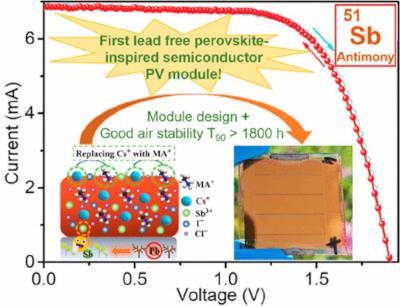Lead-halide perovskites hold great promise as the next generation of PVs, but unstable lead exposure through gas, water, and soil accumulation could have detrimental consequences if not properly controlled and recycled as perovskite use expands globally. There are also stability issues limiting operational lifetime for lead-perovskite devices themselves. Researchers have attempted to replace lead with slightly less toxic tin, but thus far tin-based perovskites still suffer from air instability. Without breakthroughs in stability and environmental safety, scaling perovskite solar technology could flood our waste stream with hazardous materials. Now, researchers from CHOSE (Centre for Hybrid and Organic Solar Energy) at the University of Rome Tor Vergata have addressed the concerns regarding toxicity and recyclability associated with the lead contained in perovskite solar cells.
Image credit: ACS Energy Letters
The scientists may have found a solution in a new lead-free antimony-based perovskite solar cell design. Their recent research demonstrates a mixed-cation perovskite-inspired material (PIM) that boosted efficiency by 81% compared to conventional cesium-only antimony solar cells, while also exhibiting unmatched stability.
The scientists said that the antimony PIM maintained 90% of its efficiency after 1,800 hours in ambient air conditions. This durability enabled the team to manufacture the perovskite solar module using industry-standard laser patterning techniques, which is a major step toward commercial viability.
Antimony is a silvery-white metalloid that boasts similar elecronic properties to lead, can bond with halides to form perovskite-like crystal structure, and potentially exhibit lower toxicity than lead, which must be analyzed from different angles (e.g., toxicity of elements and derivative compounds according to different tests, environmental footprint, life cycle analysis, which depends also on efficiency and performance etc.)
Early antimony-based devices showed potential but lacked large area and stability required for commercial relevance. By engineering a new mixed-cation methylammonium-cesium antimony triiodide chloride composition, the researchers unlocked substantial improvements on both fronts. The optimized solar cell achieved 1.53% efficiency – an 81% boost over cesium-only devices; yet still significantly lower than lead-based perovskite solar cells, which have already been shown to reach very high efficiencies in laboratory settings. Far exceeding stability benchmarks, the antimony films maintained nearly full efficiency after prolonged exposure to air and humidity.
The scientists believe that these findings could position antimony as the next-gen successor to toxic lead-based perovskites and unstable tin alternatives.
Bolstered by the antimony cell’s durability, the team stated that it became the first ever to fabricate a lead- and tin-free perovskite solar module using industry-standard laser patterning in air – evaporating unwanted layers to isolate individual cells connected in series.
Previously, longer air exposure during patterning quickly degraded lead-free perovskite films, e.g. tin-based ones. But the antimony PIM’s resilience enabled tuning specialized laser fluency parameters with all steps performed in ambient air.
The antimony minimodule achieved 1.2% efficiency over a 2.52 cm2 active area, proving the concept’s feasibility. With room for optimization, the antimony roadmap mirrors early lead-perovskite solar module development which climbed from 5% to over 20% efficiency in under a decade. More immediately, enhanced stability unlocks pathways to commercial manufacturing.
By tackling efficiency while maintaining stability – the inverse of tin’s challenges – antimony-perovskites could close the gap with the current lead-based panels on performance too. Further research will focus on device physics, while also investigating true sustainability considering recyclability and life cycle analyses.
In any case, the team’s antimony innovation represents a promising stride toward economical solar energy free of toxic tradeoffs.


